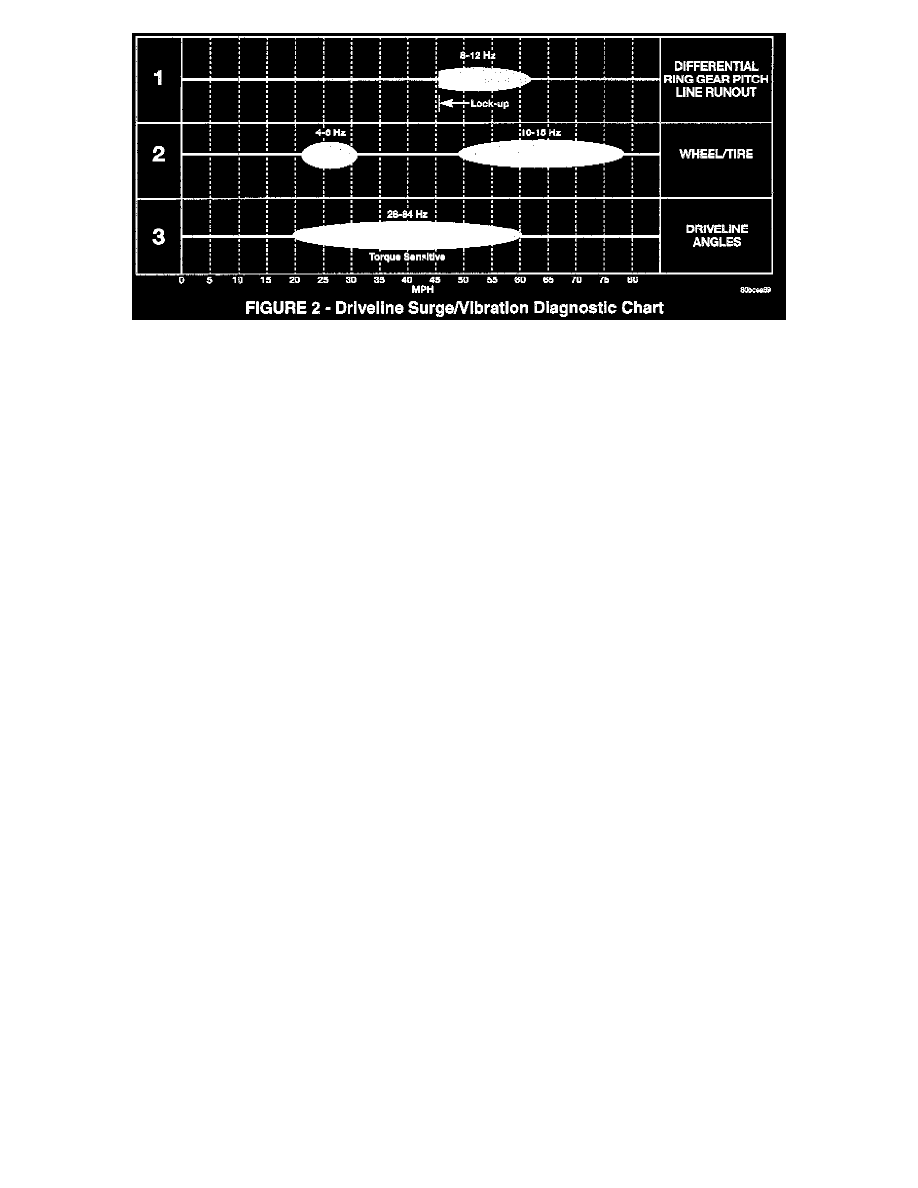1500 4x4 Pickup V8-360 5.9L Magnum (1996)

2.
Use the following chart (Figure 2) to help identify driveline components that may cause surge/vibration.
3.
If the surge/vibration starts to occur at approximately 20 mph (32 kph) and starts to go away at approximately 60 mph (97 kph) and is torque
sensitive, perform the Driveline Angle Diagnosis. If the surge/vibration starts to occur at approximately 22 mph (35 kph) and goes away at
approximately 32 mph (51 kph) and/or starts to occur at approximately 48 mph (77 kph) and goes away at approximately 78 mph (126 kph),
perform the Wheel/Tire Diagnosis. If the surge/vibration starts to occur at approximately 45 mph (72 kph) and when the torque converter clutch
engages (torque converter clutch must be engaged) and then goes away at approximately 62 mph (100 kph), perform the Rear Axle Diagnosis.
Driveline Angle Diagnosis
1.
Driveline angle surge/vibration occurs at approximately 20 mph (32 kph) and starts to go away at approximately 60 mph (97 kph) and is torque
sensitive. If using the EVA, driveline surge/vibration will occur at approximately 28 - 84 Hz. Refer to the 1999 Ram Truck Service Manual
(Publication No. 81-370-9108), pages 3-3 for information regarding propeller shaft and universal joint driveline vibration diagnosis. The driveline
angle must be measured. Follow the service procedures identified in the 1999 Ram Truck Service Manual (Publication No. 81-370-9108), pages
3-4 through 3-6. All measurements must be taken at curb weight with the vehicle supported by its wheels/tires. Normal joint angles for the Ram
Truck 4X4 are 1-5° with a 1° maximum difference between joints in a series. Driveline angles that exceed the 10 maximum difference between
joints in a series must have the axle shimmed using p/n P4529536.
CAUTION:
IT IS EXTREMELY IMPORTANT TO HAVE A LEAST THREE (3) THREADS OF THE SPRING U-BOLT SHOWING WHEN THE NUT IS
TORQUED TO ITS PROPER SPECIFICATION. TO ENSURE THAT THE U-BOLT HAS THE PROPER CLAMPING FORCE, THERE
SHOULD BE NO MORE THAN TWO (2) SHIMS USED PER SIDE.
Wheel/Tire Diagnosis
1.
Wheel/Tire surge/vibration starts to occur at approximately 22 mph (35 kph) and goes away at approximately 32 mph (51 kph) and/or starts to
occur at approximately 48 mph (77 kph) and goes away at approximately 78 mph (126 kph).
If using the EVA, wheel/tire surge/vibration will occur around the 4 - 6 Hz range and around the 10 - 16 Hz range. Tires and wheels must first be
properly balanced. Follow the recommendations from the manufacturer of your tire/wheel balancer for proper tire/wheel balance information.
2.
If the tires/wheels are properly balanced and the surge/vibration still occurs at the previously described speed range, perform the Match Mounting
service procedures in the 1999 Ram Truck Service Manual (Publication No. 81-370-9108), page 22-5.
3.
If all tires are properly mounted to the wheel and the surge/vibration still occurs at the previously described speed range, perform the Tire And
Wheel Runout diagnosis in the 1999 Ram Truck Service Manual (Publication No. 81-370-9108), pages 22-8 and 22-9.
4.
If the tires and wheels are within the specifications listed in the Service Manual and the surge/vibration still occurs at the previously described
speed range, the tires and wheels could have a force variation condition that may cause a driveline surge/vibration. If tire balancer H-9702-DD-R
(or equivalent) is not available to determine tire force variation, the tires should be exchanged with a Ram Truck that does not exhibit the
surge/vibration condition. If the exchanged tires correct the condition, replace the original tires. If the exchanged tires have no effect on the
surge/vibration, re-evaluate the surge/vibration to verify whether or not the surge/vibration starts to occur just as the torque converter clutch
engages. If the surge/vibration is sensitive to torque converter clutch engagement, perform the Rear Axle Diagnosis.
NOTE:
RETURN THE EXCHANGED TIRES TO THE ORIGINAL VEHICLE.
Rear Axle Diagnosis
Rear axle pitch line runout on the 4X4 Ram 1500 Truck with a 9-1/4 in. axle and 3.55:1 axle ratio can cause a surge/vibration to start to occur at
approximately 45 mph (72 kph) at the point when the torque converter clutch first engages (torque converter clutch must be engaged) and then goes away
at approximately 62 mph (100 kph). The condition will be most noticeable when the vehicle is under a light load (e.g driving up a small hill). If using the
